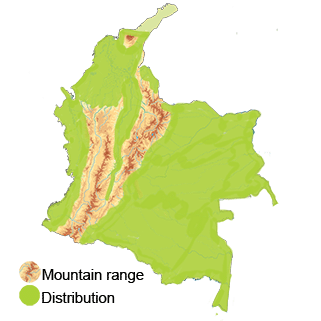Common Potoo
The Common Potoo (Nyctibius griseus) Read in Spanish
Appearance: The Common Potoo is a large nocturnal bird known for its cryptic plumage that resembles tree bark, helping it blend seamlessly with its environment. It has a large head with a massive mouth, a short neck, and large eyes adapted for nocturnal vision. Its plumage is mottled in shades of gray and brown, providing excellent camouflage against tree branches.
Habitat: Common Potoos are typically found in tropical and subtropical forests, including rainforests, mangroves, and wooded savannas. They prefer open woodlands with scattered trees where they can perch and remain hidden during the day.
Behavior: Common Potoos are primarily nocturnal, spending the day roosting on branches to avoid detection by predators. They are known for their cryptic behavior, relying on their camouflage to remain motionless and blend in with their surroundings. These birds are skilled hunters, capturing insects in mid-air using their wide mouths and agile flying abilities.
Breeding: During the breeding season, Common Potoos engage in courtship displays that may involve vocalizations and aerial maneuvers. They typically lay one egg on a bare branch or tree stump, relying on their camouflage to protect the egg from predators. Both male and female birds participate in incubating the egg and caring for the offspring once it hatches.
Conservation Status: The Common Potoo is generally considered to be of Least Concern in terms of conservation status by the International Union for Conservation of Nature (IUCN).
Distribution
The Common Potoo (Nyctibius griseus)
Amazon Rainforest: The common potoo is found in the Amazon region of Colombia, which includes departments such as Amazonas, Caquetá, and Putumayo. It inhabits the dense forests and riverine habitats of this region.
Orinoco Basin: This bird species can also be spotted in the Orinoco Basin region, which includes departments like Vichada, Meta, and Guainía. It is often seen in riparian areas and forested habitats along rivers.
Pacific Coast: The common potoo is present in parts of the Pacific Coast region of Colombia, particularly in the Chocó department. It can be found in mangrove forests and other coastal habitats.
Eastern Andes: In the Eastern Andes region, the common potoo is sometimes observed in the foothills and lower elevation forests in departments such as Tolima and Huila.
Caribbean Coast: While less common, the common potoo may also occur in the Caribbean Coast region of Colombia, in areas with suitable forested habitats.
Taxonomy
The Common Potoo (Nyctibius griseus)
- Kingdom: Animalia
- Phylum: Chordata
- Class: Aves (Birds)
- Order: Caprimulgiformes
- Family: Nyctibiidae
- Genus: Nyctibius
- Species: Nyctibius griseus
Vocalization
The Common Potoo (Nyctibius griseus)
- Song: The Common Potoo is known for its haunting and mournful song, often described as a single, mournful, drawn-out "whooooo" sound. This call is typically repeated at regular intervals and can carry over long distances in the still night air.
- Growls and Barks: In addition to its distinctive song, the Common Potoo may also emit growls and barks, especially during territorial disputes or interactions with other individuals. These vocalizations can range from low, guttural growls to sharp barks.
- Hisses and Chattering: When agitated or threatened, the Common Potoo may produce hissing sounds or rapid chattering noises, which serve as warning signals to potential predators or intruders.
- Bill Clacking: The Common Potoo may also produce bill-clacking sounds, often as part of courtship or aggressive interactions. This sound is created by the rapid clapping of the bird's bill and is distinctive in its sharp, percussive quality.







